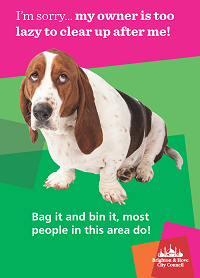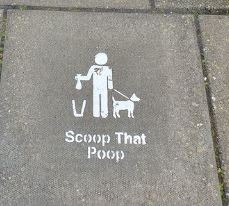The Round Hill Society
The home site of the Round Hill Society, a community group of the residents of Round Hill in Brighton, England. The site contains information about the area, latest news and reflections on life in Round Hill.
Dog mess
Brighton and Hove City Council (Cityclean) will clean up dropped litter, dog mess, and hazardous/dangerous materials left in public places.
To report dog fouling telephone Cityclean on 01273 292929
We're watching you BHCC's 2017 clamp down.
Keep Britain Tidy solutions (includes the above campaign)
Dog fouling & what to do about it [2021]
Actions you can take yourself
 Failure to pick up after a dog has fouled a public open space (such as a pavement, road, park, field, or the beach) could cost the owner a fine of up to £1000.
Failure to pick up after a dog has fouled a public open space (such as a pavement, road, park, field, or the beach) could cost the owner a fine of up to £1000.
Click here to inform the Council about a regular problem of dog mess.
Click on the mini-picture to the left for a large PDF version which can be printed, laminated and displayed.
Pavement Clean It Up stencils

Highlighting the problem
The Round Hill Society has had several pavement stencils, which volunteers have deployed at prominent sites, especially places where the problem of dog mess frequently occurs.
Use of public media (radio / newspaper)
Neil Pringle from BBC Radio Sussex interviewed Sandy Hawkins from The Round Hill Society on the above idea to encourage owners to clean up after their dogs. A concurrent newspaper article focused on the health risks (TOXOCARIASIS) posed - especially to young children with the habit of putting their hands in their mouth - by roundworm parasites found in mess from cats, dogs and foxes.
Both reports emphasize the need to find a good solution which does not prove counterproductive by leading to ill-tempered confrontation.
Revised by-laws following consultation
Consultation ended on Friday 28th March 2008. 
Failing to remove dog faeces -
To include all open air land that the public has access whether by payment or not.
• All streets, pavements, (including the bases of trees) roads,
promenades, under-cliff walk etc throughout Brighton & Hove All Brighton and Hove Council owned land including parks, open plan gardens, car parks etc
• All land belonging to Town & Parish Councils
• All rights of way that cross land owned by the primary and
secondary authorities
• All other land in the open air to which the public have access to
with or without payment other than the land listed in the exemptions below.
Land from which dogs are excluded.
• All children's playgrounds
• The following school playing fields
Varndean School
Varndean 6th Form
Dorothy Stringer High School
Belfour Infant and Junior School
Cardinal Newman
Blatchington Mill
Patcham Fawcett
St Bernadettes
BHASVIC
• Brighton & Hove Cemeteries
Borough Cemetery (Woodvale)
Lewes Road; Extra Mural Cemetery
Lewes Road; Borough Cemetery
Bear Road; Jewish Cemetery
Meadowview and Lawn Memorial Cemetery Warren Road
Hove Cemetery North and South
Portslade Cemetery
With the following exemptions (to any person attending a funeral or remembrance service or a person residing in premises of the specified cemeteries - these dogs must be kept on a lead at all times.)
• Squares, Gardens, Beaches, Walks
• Brunswick Square, Norfolk Square, Russell Square, Bedford Square, Clarence Square, Pelham Square, Regency Square (North End), Steine Memorial Gardens
• The beaches between the months of May to September
Keeping Dogs on a lead
• On all streets, roads and pavements
• The under-cliff walk
• Hollingbury Park & Waterhall Golf Course
Putting and keeping a dog on a lead when directed to do so by an authorised officer:-
To include all open air land in Brighton & Hove that the public has access whether by payment or not, if the dog is seen to be out of control, causing a threat to persons or other animals.
Exemptions: The Poo Control Order does not apply to the following land types:-
Woodland
Marshland
Moorland
Common Land
Agricultural Land
Privately owned gardens
Forestry Commission Land
This is in keeping with the spirit of the Dog Fouling of land Act 1996, and takes in to account the practicalities of how difficult it would be to physically enforce the control order on open, unfenced land. Assistance dogs will be exempt from the dog control orders.
Background to consultation
The council consulted residents and groups on proposals to help make our city a pleasant and safe environment for dogs, their owners, residents and visitors. The proposals included new rules on cleaning up after dogs, keeping them on leads and in small groups.
Following consultation in autumn 2007, the council drew up a revised set of by-laws and in 2008 invited comments before they were presented to the Council for approval in spring. The new proposals took on board the suggestions of many of those who responded to the autumn consultation.
Local Authorities have had powers to enforce legislation relating to the control of dogs for a number of years. Over time the legislation has become outdated, disjointed and confusing for members of the public. These new orders aim to simplify the legislation, and allow a greater flexibility in where the legislation can be applied and the range of offences that can be covered under the one order.
The procedure for making a Dog Control order is set out in regulation 3 of the Dog Control Orders Regulations 2006. The authority needs to balance the interests of those in charge of dogs against the interests of those affected by the activities of dogs, in particular consideration should be given to children to have access to dog free areas.
Penalties for committing an offence contained in the Dog Control Orders are a maximum of Level 3 on the standard scale £1,000.
Alternatively Fixed Penalty Notices can be issued for these offences and may be offered in place of prosecution.
Guidance has been issued by the government, stating that the level of fines that can be set for offences within a dog control order is £50 - £80, and where no fine is set by the local authority the fine is to be £75. It is therefore proposed that the fine for each dog control order made, should be set at the maximum of £80.
Legal References
Clean Neighbourhood and Environment Act 2005 (Sections 55 and 56), to replace the current bylaws relating to dogs and the Dogs (Fouling of the Land) Act 1996. The Clean Neighbourhood and Environment Act guidance suggests that a maximum of 6 dogs can be effectively controlled by any one person. It is proposed that this requirement is debated as part of the consultation process with all the relevant stakeholders.
The procedure for making a Dog Control order is set out in regulation 3 of the Dog Control Orders Regulations 2006
Dogs (Fouling of the Land) Act 1996